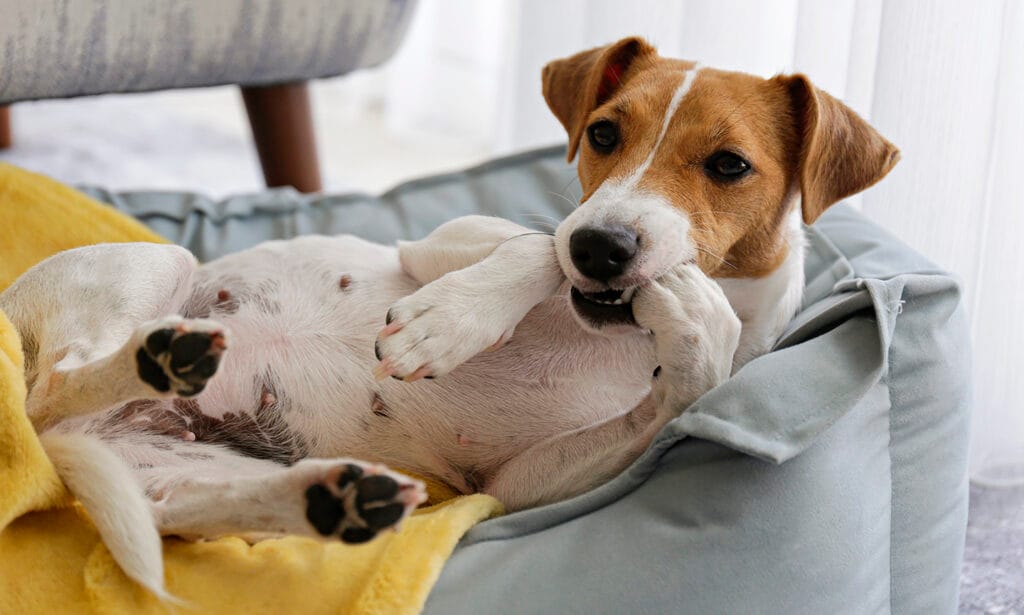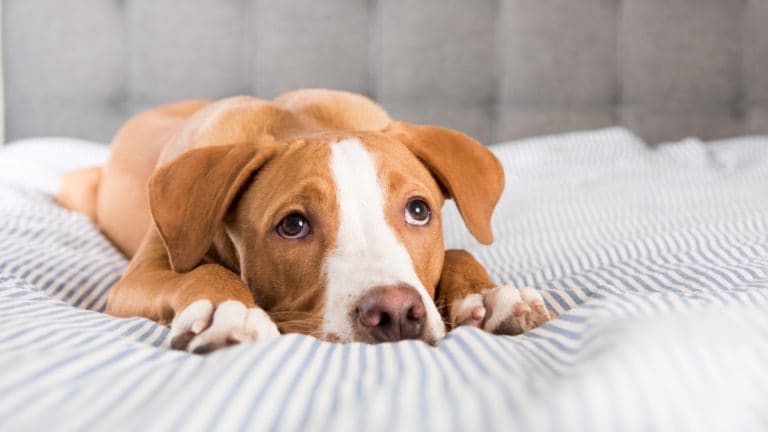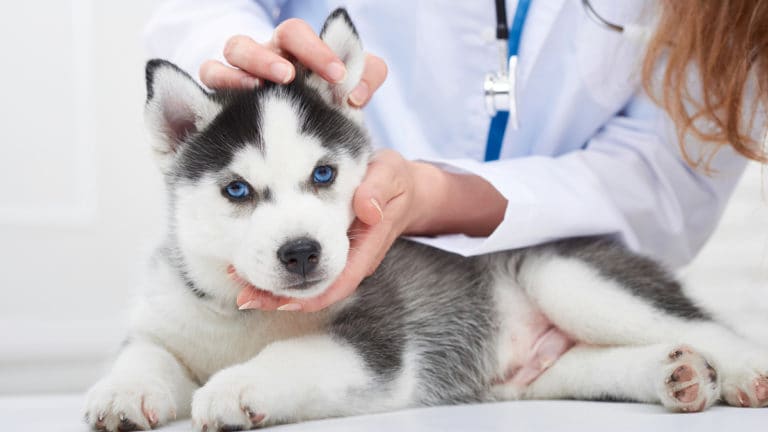Yeast infections in dogs can cause some seriously uncomfortable symptoms—think constant itching, irritated skin, and that unmistakable “yeasty” smell similar to Fritos corn chips. (Sorry if we just ruined that snack for you!)
While yeast—a type of fungus—naturally lives on a dog’s skin and in their ears, overgrowth can turn into an infection that leaves your dog feeling miserable.
So, what exactly causes a yeast infection in dogs, and how can you help your canine companion find relief? We spoke to veterinarians to learn the common causes, signs to watch for, and how vets treat yeast infections in dogs.
In This Guide:
What Are Yeast Infections in Dogs?
“Yeast infections in dogs are typically caused by an overgrowth of Malassezia, a type of yeast that usually lives on a dog’s skin, ears, and mucous membranes in small amounts,” explains Antje Beth-Joslin, DVM, co-owner of Tolleson Animal Clinic, in Tolleson, Arizona, and consultant for Dogtopia, a dog day care center with locations across the US.
In healthy dogs, the immune system and good bacteria naturally keep yeast in check, she adds. However, given the right conditions, yeast can overgrow and cause an infection.
Dogs with skin folds, droopy ears, a thick or long coat, or skin that is prone to excessive oil production (called seborrhea) are especially at risk.
Breeds particularly prone to yeast infections include:
- Shih Tzu
- Cocker Spaniel
- Miniature Schnauzer
- Chinese Shar-Pei
- French Bulldog
- English Bulldog
- American Pit Bull Terrier
- Bloodhound
- Golden Retriever
- Labrador Retriever
- Basset Hound
- West Highland White Terrier
- German Shepherd
- Silky Terrier
- Shetland Sheepdog
- Bichon Frise
- Maltese
- Dachshund
- Pug
- Poodle
- Chihuahua
Types of Yeast Infections in Dogs and How to To Spot Them
Yeast infections in dogs commonly affect the ears, paws, skin, and skin folds. Recognizing the signs early can help you address the problem before it becomes severe.
Yeast Infections in Dogs’ Ears
Too much yeast in dogs’ ears can lead to painful, itchy ear infections (aka yeast otitis) if left untreated.
Symptoms include:
- Frequent head shaking or tilting
- Scratching or rubbing ears against surfaces
- Red, inflamed ear canals
- Brown or yellow discharge
- Sensitivity or pain when ears are touched
- An unpleasant musty or cheesy smell
Yeast Infections in Dogs’ Paws
Paws are another common spot for yeast infections, especially in dogs who lick their feet excessively or spend a lot of time outside in damp environments.
Symptoms include:
- Excessive chewing or licking of paws
- Red, swollen skin between the toes
- Discolored fur (reddish-brown) from saliva
- Limping or discomfort while walking
- An unpleasant musty or cheesy smell
Skin Yeast Infections in Dogs
Skin yeast infections (aka yeast dermatitis) can occur anywhere on a dog’s body but are particularly common in areas with folds, such as the groin, armpits, or belly.
Symptoms include:
- Red, irritated, or flaky skin
- Itchy skin; frequent licking or chewing of the affected area
- Small red bumps on the skin
- Brown discoloration of the skin
- Greasy skin
- Hair loss in affected areas
- Thickened or “elephant-like” skin texture
- An unpleasant musty or cheesy smell
What Causes Yeast Infections in Dogs?
Yeast infections in dogs are often linked to underlying conditions that disrupt the skin’s natural balance or weaken the immune system.
Factors such as itchiness—which leads to scratching and licking—and excess moisture can also contribute, as yeast thrives in warm, damp environments.
Common causes of yeast infections in dogs include:
- Allergies (food or environmental)
- Fleas and mites
- Metabolic disorders, such as hypothyroidism or Cushing’s disease
- Weakened immune system due to illness, stress, or certain medications
- Lack of regular cleaning, especially in the ears, paws, and skin folds
- Wet fur or trapped moisture, especially in skin folds or ears, which encourages yeast to grow
How Do Vets Treat a Dog Yeast Infection?
If you suspect your dog has a yeast infection, a visit to your vet is in order. They’ll guide you on how to treat yeast infections in dogs effectively.
Here’s what to expect:
- Diagnosis: Your vet will examine the affected area and might take skin scrapings, swabs, or ear samples to view under a microscope to confirm the presence of yeast, Dr. Beth-Joslin says. They might also do blood work and other tests to check for underlying causes.
- Topical treatments: Medicated shampoos, ointments, wipes, or sprays containing antifungal ingredients, such as chlorhexidine or miconazole, are often prescribed to treat skin yeast infections, Dr. Beth-Joslin says. Yeast infections in dogs’ ears are treated with antifungal ear medications.
- Oral medications: Dr. Beth-Joslin says oral antifungal medications, such as ketoconazole or fluconazole, might be necessary to combat systemic, internal yeast infections.
- Consideration of underlying issues: If an underlying health issue is found, your vet will develop a plan to manage or treat the condition.
The treatment course typically lasts two to four weeks, depending on the severity of the infection, says Dr. Beth-Joslin. If the yeast infection is recurrent or widespread, treatment can take several weeks to a few months.
When caught early and treated promptly, yeast infections can show improvement within a few days to a week.
How Can I Help My Dog With a Yeast Infection?
While your veterinarian sets the treatment plan, it’s your job to follow through and support your pup’s recovery. Here’s how you can help.
Follow Your Vet’s Instructions
Administer all prescribed treatments—including topical creams, ear drops, or oral antifungal medications—exactly as directed.
Bathe Your Dog With Medicated Shampoo
If advised by your vet, using an antifungal medicated shampoo, MiconaHex+Triz Shampoo, Douxo S3 PYO Antiseptic Antifungal Chlorhexidine Shampoo, or Malaseb Shampoo, can help treat the yeast infection.
Clean Affected Areas With Medicated Wipes
With your vet’s approval, use antifungal wipes, such as Douxo S3 PYO Antiseptic Antifungal Chlorhexidine Wipes and Mal-A-Ket Wipes, to gently clean and treat the infected areas.
Dry Your Dog Thoroughly
After baths, swimming, or walks in damp weather, gently dry your dog’s skin and fur—especially between paws, in skin folds, and around ears.
Prevent Licking
Excessive licking can worsen yeast infections and delay healing.
Use a Elizabethana recovery cone collar, like All Four Paws Comfy Cone E-Collar, to prevent your dog from licking the affected areas.
When Should I Contact My Vet?
While most yeast infections begin to improve within a few days of starting your vet’s recommended treatment, Carol Osborne, DVM, owner of Chagrin Falls Veterinary Center & Pet Clinic, in Chagrin Falls, Ohio, says you should reach out to your vet if:
- Symptoms worsen or don’t improve after three to seven days
- Your dog shows signs of pain, such as whining, whimpering, or avoiding touch
- Your dog reacts poorly to prescribed medication; signs include vomiting, diarrhea, and lethargy
- Excessive licking or scratching persists, preventing the area from healing
How Do I Prevent Yeast Infections in My Dog?
Taking proactive steps to reduce the risk of yeast infections is far easier—and better for your pup—than dealing with a full-blown infection. Here’s what you can do:
- Keep your dog dry. Always dry your dog thoroughly after baths, swimming, or rainy walks, paying close attention to ears, paws, and skin folds.
- Clean ears regularly. Use a dog-specific ear cleaner, such as Virbac Epi-Otic Advanced Ear Cleaner, to keep your dog’s ears free of wax and debris.
- Clean skin folds regularly. If your dog has skin folds, clean them regularly with wipes, such as Douxo S3 PYO Antiseptic Antifungal Chlorhexidine Wipes, to prevent the buildup of moisture, dirt, and bacteria.
- Groom regularly. Keep fur trimmed around areas that trap moisture, including paws, ears, and skin folds, to improve airflow and prevent yeast growth.
- Bathe with medicated shampoos (as needed). If your dog is prone to yeast issues, your vet might recommend regular baths with an antifungal shampoo.
- Consider probiotics. Probiotics, such as Nutramax Proviable Probiotics & Prebiotics Capsules Digestive Supplement and Purina Pro Plan Veterinary Diets FortiFlora, help maintain a healthy balance of beneficial bacteria in a dog’s gut. Dr. Osborne says this can strengthen the immune system and make it harder for yeast to thrive.
- Stay on top of flea and tick prevention. Regularly using vet-approved flea and tick preventatives helps protect your dog from parasites that can cause itching and skin damage.
- Address underlying issues. Work with your vet to monitor for and treat any underlying health problems.
- Check for signs early. Routinely inspect your dog’s paws, ears, and skin for redness, odor, or discharge so you can catch potential yeast overgrowth early.
FAQs About Yeast Infections in Dogs
Q:Can yeast in dogs cause ear infections?
A:Absolutely—the warm, moist environment of a dog’s ear canal is a yeast paradise, and too much yeast can lead to an itchy ear infection.
Q:Can I use a dog yeast infection home remedy?
A:If you’re concerned your dog has a yeast infection, schedule an appointment with your veterinarian to have their skin and/or ears examined.
It’s always best to determine the cause of the skin or ear issue and to get a treatment plan for the problem. This can lead to a faster recovery for the dog.
If you prefer to do topical therapy instead of oral, let your veterinarian know if medicated or prescription shampoos would be beneficial. You can also ask about using medicated wipes and mousse.
Q:Can yeast infections in dogs spread to humans or other pets?
A:While it is possible for it to spread to people, especially to those who are immunocompromised, yeast infections in dogs are not contagious to other pets. However, underlying causes such as fleas or environmental allergens can affect multiple pets in the household.
This content was medically reviewed by Jo Cornett, DVM, Chewy veterinarian.
Share:























